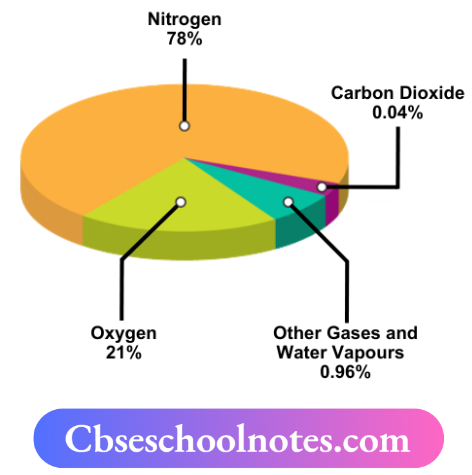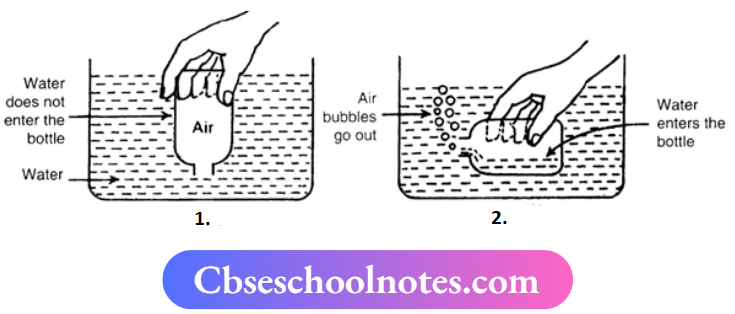Air Around Us

Air Around Us Properties Of Air
Some of the properties of air are given below.
- Air is invisible, and it can only be felt.
- It occupies space.
- It is colorless, odourless, and transparent.
- It takes the shape and odor of the object or place where
- It is present in.
- It is a mixture of different gases and another particle
Presence Of Air
Atmosphere
The thin layer of air surrounding the Earth is called the atmosphere. This thin layer extends up to many kilometers above the surface of the Earth. It filters out harmful radiations and other particles entering into the Earth’s atmosphere.
We know that mountaineers carry oxygen cylinders with them while climbing high mountains. This is necessary because the amount fair reduces as we move higher in the atmosphere. At higher altitudes, the level of oxygen is very low creating breathing problems
Science Insight:
A thin layer of ozone is present in the upper atmosphere. It protects the Earth by blocking harmful rays coming from the Sun.
Read and Learn More Class 6 Science Notes
Composition Of Air
Air is a mixture of many gases. The major components of air are nitrogen (78%) and oxygen (21%). The remaining 1% contains carbon dioxide, water vapor, argon and a few other gases, along with dust and smoke. The composition of dust and smoke varies from time to time and place to place

Let s study these components of air in detail
1. Water Vapour
It is the water present in gaseous form in the air and can be formed through the process of evaporation.
- This is why when air comes in contact with cool surfaces, these vapors condense into drops of water,
- Example: Appearance of water drops on the surface of a glass containing ice during summer. Water vapor in air is important for the water cycle in nature.
2. Oxygen
- It is an essential component present in the air. Survival of all living beings on land and in water is because of oxygen.
- It is a vital part in the respiration process in all living beings, and also a supporter of burning.
- It does not burn but is required in the burning of a substance or a fuel.
Presence of Oxygen in Water and Soil:
- Animals and plants living in water are aquatic organisms. These organisms use oxygen, which is dissolved in water for breathing.
- Those organisms which live in soil and plants (through their roots) use the air present in between the space of soil particles.
3. Nitrogen
It is a major component of air. It is required by both plants and animals for their growth, but they are not able to absorb the nitrogen directly from the air. Nitrogen is first converted to nitrate only, then plants absorb it from the soil. Animals absorb it by consuming food prepared by plants. Unlike oxygen, nitrogen does not support burning.
4. Carbon Dioxide (CO2)
It is also an essential component of air like oxygen that makes a small composition in the air plants consume carbon dioxide while making their food by the process of photosynthesis.
- On the other hand, we take in oxygen and give out carbon dioxide during respiration. Burning of plant and animal matter also uses oxygen, and in turn, carbon dioxide is given out.
- We feel suffocated if we burn something in a closed room. This is due to the excess of CO2 present in the room. So, it is advisable not to burn dry leaves and discarded remains of the crop, which causes pollution.
- It does not support burning and can be used as a fire extinguisher to put off the fire.
5. Dust and Smoke
The burning of fossil fuels produces smoke. It contains few gases and fine dust particles which are harmful to living organisms.
- Long chimneys could be seen in factories. It takes the smoke and dust particles away from our noses, but in turn, it is harmful to birds flying up in the sky.
- Dust particles are always present in the air in winter, we observe a beam of sunlight that filters through the trees.
- In which dust particles appear to dance merrily. Fine hair and mucus present inside the nose prevent the dust particles when we breathe.
Why do traffic policemen wear masks?
The traffic policemen who regulate traffic at a crowded city road crossing often wear masks. The traffic policemen wear masks to protect themselves from the smoke containing harmful gases which are emitted by the vehicles moving around them.

Replacement Of Oxygen In Atmosphere
All living organisms consume oxygen present in the air. The process of respiration by plants and animals uses oxygen present in the air. It is constantly replaced by plants through the process of photosynthesis.
- In this process, plants make their food, and oxygen is produced. Plants also consume oxygen for respiration, but they produce more of it than they consume.
- That is why, we say, plants produce oxygen.
- Animals cannot live without plants. The balance of oxygen and carbon dioxide in the atmosphere is maintained through respiration and photosynthesis. This shows the interdependence of plants and animals.
Uses of Air
We have seen how valuable the resource of air is. All of its components are vital for life on Earth.
Here, some uses of air are given below:
- It exerts pressure on objects that come in its way.
- It regulates temperature.
- Wind is used to rotate windmills. It is used for various purposes like drainage water from tube wells, running flour mills, generating electricity, etc.
- It is used by living organisms for breathing.
- It is used to inflate the tires of vehicles.
- It is used for the winnowing process.
- It helps in the traveling of sound and smell as when air moves, it carries sound and smell to a distance
- It helps in the movements of sailing yachts, gliders, parachutes, and airplanes. Birds and insects can fly due to the presence of air.
- It also helps in the dispersal of seeds and pollen of flowers of several plants.
- It plays an important role in the water, nitrogen, and oxygen cycle.
Activity 1
Aim:
To show the presence of air with the help of a firkin.
Materials Required:
Paper, stick, scissors, etc.
Procedure:
- Make a firki by using a paper strip.
- Hold the stick of the firki and move it in different directions.

Observation:
We will observe that the firki starts rotating. The firki moves/rotates when the air strikes its blades.
Conclusion:
We conclude that air is present around us
Activity 2
Aim:
To show that air occupies space using an empty bottle.
Materials Required:
Empty glass bottle, container, filled with water etc.
Procedure:
- Take an empty glass bottle.
- Now, hold the bottle in an inverted position (with its open mouth facing downwards) in a container filled with water.
- Observe if water enters the bottle.
- Now, tilt the bottle in water and observe it.

Observation:
- The water does not enter into the inverted glass bottle.
- In tilted glass bottle. Air present in the bottle goes out in the form of air bubbles. As the air from the ott e pes, water starts entering the glass bottle and occupies the place of air.
Conclusion:
We conclude that the glass bottle which appears to be empty is filled with air.
Activity 3
Aim:
To demonstrate the presence of oxygen in air which supports burning.
Materials Required:
2 candles, matchbox, 2 glass
Procedure:
- In the presence of your teacher, fix two small candles of the same size. Light both the candles.
- Cover one of the candles with an inverted glass and observe

observation:
It is observed that the candle covered with a glass tumbler was extinguished after some time whereas the other candle continued burning
Conclusion:
We concluded that air contains some amount of oxygen and it supports burning
Activity 4
Aim:
To show the presence of dust particles in the air.
Materials Required:
Black curtains or black chart papers.
Procedure:
- Find a room in a school/home.
- Close all the doors and windows with the help of black chart paper or black curtains.
- Make a small hole in the black chart I have fixed on the window, facing the Sun, and observe.
Observing the presence of dust in the air with sunlight:

Observation:
- A thin beam of sunlight enters the room through the small hole made in the chart.
- We could see the tiny dust particles moving in the beam of light in the dark room.
Conclusion:
- We conclude that air also contains dust particles.
- The presence of dust particles in the air varies from time to time and from place to place.
Activity 5
Aim:
To show the presence of dissolved air in water.
Materials Required:
Tumbler/beaker, water, tripod stand, burner.
Procedure:
- Take a number/beaker filled with water and keep it on a tripod stand
- Heat the water slowly by using a burner.

Observation:
Before the water begins to boil, tiny bubbles appear on the inner surface of the tumbler/beaker. These bubbles are of air dissolved in water.
Conclusion:
We conclude that water contains dissolved air and when it is warmed, air comes out in the form of bubbles
Activity 6
Aim:
To show that soil contains trapped air.
Materials Required:
Small jar, water, soil.
Procedure:
- We take a small jar filled with water.
- Add a handful of soil into the jar and observe the changes that occur.

Observation:
While adding the soil into the jar, air bubbles observed which are formed in water. This shows that the soil contains some air trapped in between its soil particles.
Conclusion:
We conclude that soil contains trapped air, which helps the organisms to survive that live inside the soil. Also, the roots of plants respire by using this air.
